
The sap beetles, also known as Nitidulidae, are a family of beetles.

Zopheridae is a family of beetles belonging to Tenebrionoidea. It has grown considerably in recent years as the members of two other families have been included within its circumscription; these former families are the Monommatidae and the Colydiidae, which are now both included in the Zopheridae as subfamilies or even as tribe of subfamily Zopherinae. Some authors accept up to six subfamilies here, while others merge all except the Colydiinae into the Zopherinae.

Melolonthinae is a subfamily of the scarab beetles. It is a very diverse group; distributed over most of the world, it contains over 11,000 species in over 750 genera. Some authors include the scarab subfamilies Euchirinae and Pachypodinae as tribes in the Melolonthinae.

Erotylidae, or the pleasing fungus beetles, is a family of beetles belonging to Cucujoidea containing over 100 genera. In the present circumscription, it contains 6 tribes and 10 subfamilies. In other words, the narrowly circumscribed Erotylidae correspond to the subfamily Erotylinae in the definition sensu lato. There are doubts on the monophyly of lower ranked taxa within Erotylidae, with further phylogenetic studies requiring better sampling and studies of unexplored character sets, for example the metendosternite and penile flagellum, which are generally lacking detailed morphological studies within the Coleoptera literature. The Eroytlina taxonomy is based on traits such as their different colors and not off morphological differences like mouthparts, thorax, and abdominal terminalia (Pecci-Maddalena).

Meloe is a genus of blister beetles commonly referred to as oil beetles. The name derives from their defensive strategy: when threatened by collectors or predators they release oily droplets of hemolymph from their joints. This fluid is bright orange and contains cantharidin, a poisonous chemical compound. Wiping the chemical on skin can cause blistering and painful swelling of the skin. This defensive strategy is not exclusive to this genus; all meloids possess and exude cantharidin upon threat.

Melanotus is a genus of click beetles in the family Elateridae. There are at least 30 described species in Melanotus.
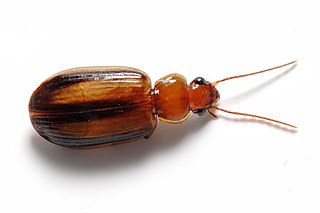
Amblytelus is a genus of ground beetle including 44 species distributed through southern Australia, including the Southwest and along the east coast up to North Queensland.

Eretes is a genus of beetles in the family Dytiscidae. The genus is native to the Afro-tropical region, the Palearctic, the Near East, North Africa and the Asian region.

Heliopetes is a Neotropical genus of spread-winged skipper butterflies in the family Hesperiidae.

The Harpactorinae are a large subfamily of the Reduviidae. About 300 genera and 2,000 species worldwide have been described. Some of the species of the genera Zelus, Pselliopus, Sinea, and Apiomerus are of interest as biological pest control agents.

Trogossitidae, also known as bark-gnawing beetles, are a small family in the superfamily Cleroidea. Many taxa formerly within this family have been removed to other families, such as Lophocateridae, Peltidae, Protopeltidae, Rentoniidae, and Thymalidae. Members of the family are generally predatory and/or feed on fungi, both in adult and larval stages, and are generally associated with wood, being found under bark or inside bored tunnel galleries. There are about 400 species in 25 genera in the family under the new, restricted circumscription, as opposed to 600 species in over 50 genera in the old definition. The oldest fossil assignable to the modern, more restricted definition of the family is Microtrogossita from the mid-Cretaceous Burmese amber of Myanmar, which has close affinities to the Trogossitini, indicating that the family had already considerably diversified by this time.
Dystrichothorax is a genus in the beetle family Carabidae. There are more than 50 described species in Dystrichothorax, found in Australia.

Enoclerus is a genus of checkered beetles in the subfamily Clerinae.
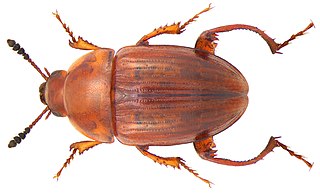
Leiodinae is a subfamily of round fungus beetles in the family Leiodidae. There are more than 60 genera and 1,800 described species in Leiodinae.
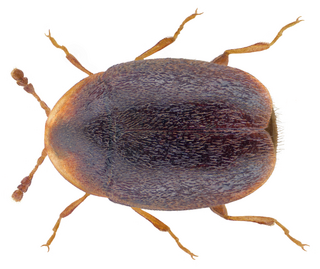
Arthrolips is a genus of minute hooded beetles in the family Corylophidae. There are more than 20 described species in Arthrolips.

Meronera is a genus of rove beetles in the family Staphylinidae. There are at least four described species in Meronera.
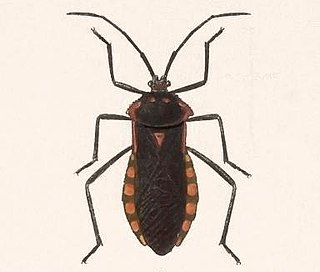
Sephina is a genus of leaf-footed bugs in the family Coreidae. There are more than 20 described species in Sephina.
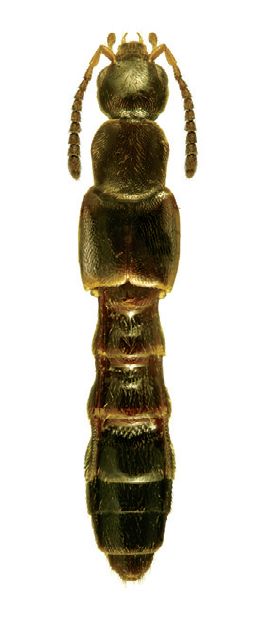
Tachyusa is a genus of rove beetles in the family Staphylinidae. There are more than 20 described species in Tachyusa.

Ammoecius is a genus of scarab beetles in the family Scarabaeidae. There are at least 20 described species in Ammoecius, found in Europe, Asia, and Africa.

Euander lacertosus, the strawberry bug, is a species of dirt-colored seed bug in the family Rhyparochromidae, found in Australia.



















